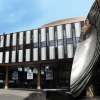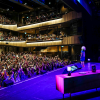Using Audience Spectrum to drive culture change and a major audience development programme
Contents
- Who are we?
- The case for an audience development programme
- Who do we want our audience to be?
- A shared language for the whole organisation
- Identifying our priority audiences using Audience Spectrum
- Putting it together: insights into action
- Supporting our ongoing audience development programme
Topics
The National Library of Scotland’s Barbara Burke outlines how Audience Spectrum is supporting their delivery of a wide-ranging audience development strategy, and driving culture change across the organisation.

Who are we?
The National Library of Scotland is many things to different people. We are one of Scotland’s national collections institutions alongside National Galleries and National Museums of Scotland.
- We are a reference library, which means you have to come to our reading rooms to consult material – we’re not a lending library.
- We collect literally everything that is published in the UK every day. If you can think of it, we probably have it.
- We are a public service – membership of the Library is free and we have about 50,000 ‘active’ members at any given time.
- We educate, entertain and inspire people throughout Scotland with exhibitions, events and touring displays.
The case for an audience development programme
The library enjoys very loyal audiences, the vast majority of whom are local to Edinburgh, affluent, and already highly engaged in cultural life.
While we don’t want to lose those audiences, we want everyone else to feel welcome in any of our spaces, from our website to our buildings. We are 90% publicly funded and so we want people to know it’s their national library.
We needed an audience development plan to act as a roadmap towards realising the goals in our 2020-2025 organisational strategy, ‘Reaching People’. But we found we didn’t have the most up-to-date expertise in this area.
So we got the experts (in this case, The Audience Agency) to deliver a two-year audience development programme which also aimed to deliver the culture change required to make us more audience-focused.
Who do we want our audience to be?
There’s an expectation from government and others that we serve the whole country as best we can, and benefit underrepresented communities more. We wanted to use audience segmentation to source these underrepresented groups, design programmes for them, and be better able to demonstrate our impact on the people of Scotland with primary funders, as well as prospective funders.
Getting buy-in from across the organisation was crucial, so we consulted staff on who they felt our primary audiences are, and who we should be prioritising. The array of responses was dizzying (as we knew it would be), as clearly audiences mean different things to different people within the organisation.
What we needed was a shared language, a human-centred approach, and insights into how to reach the people we’re not.
A shared language for the whole organisation
We find audience segmentation via Audience Spectrum effective because it is based on behaviours and interests, rather than relying on what can be unhelpful stereotypes. It also helps us to now speak the same language throughout the organisation when we refer to our diverse audiences, both current and potential.
It’s also important to us to not just see audience segmentation as something belonging only in the realm of marketing. We want to apply it across the board – including strategic planning of our programmes and projects, and enhancing our services to make them more welcoming.
Identifying our priority audiences using Audience Spectrum
Analysis of both our current audiences and our catchment area population helped us identify five Audience Spectrum segments who we consider to be a priority for the Library, for various reasons:
Experience Seekers – A group we’re already doing well in attracting to the Library, and we’re in a good position to increase those numbers. Typically highly active, diverse, social and ambitious, they engage with culture on a regular basis and we would like to reach more of them and grow awareness.
Dormitory Dependables – This group are suburban, busy and therefore picky. They’re into mainstream arts, history and heritage, and represent an opportunity for us to engage this group in a deeper way (delineating ourselves from lending libraries and boost our profile as a visitor destination).
Kaleidoscope Creativity – A mixed age, low-level cultural engagement, very diverse; a large population group, and we engage with a very low proportion of them. There is an opportunity here for broader engagement (by working closely with local libraries that already engage with various communities within this group).
Up Our Street – A middle-aged to older urban residents who like popular arts, museums and heritage but are modest in habits and means. Barriers to engaging them include their risk-averse nature, and often finance and health issues. An opportunity here for broader engagement (engaging different types of people within this group).
Trips and Treats – A largely family dominated group, living comfortable but modest lifestyles. Arts and culture engagement is largely determined by children's interests and educational requirements. An opportunity here for broader engagement (engaging different types of people within this group).
Putting it together: insights into action
Through a workshop (facilitated by The Audience Agency) which covered persona and journey mapping for our priority segments, we were able to really get under the skin of our target audiences; their lifestyles, values and motivations. As well as this practical workshop, we also created Audience Guides for colleagues to refer to and support their understanding of the key audience segments, in a simple user-friendly style.
We then began to use our understanding of the key audience segments to help design programmes of work targeting people according to how they engage with culture, and their behaviours and interests.
As we progress our audience development strategies, we’ve found that segmenting using Audience Spectrum has helped us test our assumptions, focus our efforts and take a more ‘people-focused’ approach (as opposed to ‘collections-led’).
And it has supported us in tracking our progress towards our goals (The Audience Agency also helped us develop an evaluation framework).
Supporting our ongoing audience development programme
At the midway point of our audience development programme, we’ve found that Audience Spectrum as segmentation tool is proving very useful.
As well as helping us identify priority groups and develop a shared language across the organisation, segmentation has helped us test our assumptions, focus our efforts and take a more ‘people-focused’ approach (as opposed to ‘collections-led’).
We’re now carrying out more research and testing of ideas, and creating an audience development plan for the year leading up to our Centenary in 2025 which builds on the knowledge gained through our work with segmentation so far.
Key takeaways
- The National Library of Scotland recognised the need for a strategic programme to both broaden and deepen relationships with their audiences.
- A culture change was needed across the organisation to become more audience-focused, and staff consultation was key to achieving this.
- ‘Audiences’ mean different things to different people in the organisation. Segmenting using Audience Spectrum provided clarity and a shared language.
- Segmentation has allowed for identification of priority audiences, an understanding of how to develop programmes to engage them, and a means to monitor progress.
New to Audience Spectrum?
Audience Spectrum is the most powerful segmentation tool for the UK cultural sector
Find out how it can help youCase Studies
-
 Audience Spectrum in Action | Aberdeen Performing Arts
Audience Spectrum in Action | Aberdeen Performing Arts
-
 Audience Spectrum in Action | Edinburgh International Festival
Audience Spectrum in Action | Edinburgh International Festival
-
 Audience Spectrum in Action | Securing Funding for a Circus Festival
Audience Spectrum in Action | Securing Funding for a Circus Festival
-
 Audience Spectrum in Action | London & Culture Calling Arts
Audience Spectrum in Action | London & Culture Calling Arts
-
 Audience Spectrum in Action | Theatr Brycheiniog
Audience Spectrum in Action | Theatr Brycheiniog
-
 How Audience Spectrum helped support Nottingham Playhouse's Levelling Up Strategy
How Audience Spectrum helped support Nottingham Playhouse's Levelling Up Strategy
-
 Looking ahead at Hall for Cornwall
Looking ahead at Hall for Cornwall
-
 Shakespeare North Playhouse: Audience development using Audience Spectrum as a catalyst and tool
Shakespeare North Playhouse: Audience development using Audience Spectrum as a catalyst and tool
Related Guides
- Audience Answers ticketing insights for organisations in Scotland
- Audience Answers surveys for organisations in Scotland
- Boost Your Email Marketing with Audience Spectrum - a step by step guide
- How to use Audience Spectrum to Enhance your Funding Applications
- How to Use Audience Spectrum to Inform Your Programme and Engage with Diverse Audiences
- How to use Audience Spectrum to Target Paid Online Advertising
- How to use the Audience Spectrum Segments in your Catchment Area chart on your Overview Dashboard
- Segmentation made simple
- Using Audience Spectrum Subsegments | Speak your benefactors' language
- Using Audience Spectrum Subsegments | Upsell your add-ons more effectively
- Top Tips | Using the Audience Spectrum Subsegments
- Using Audience Spectrum Subsegments | Get personal with your profiling
- Using Audience Spectrum Subsegments | Access your underserved audiences
- How understanding audience segmentation can inform your website user experience
- Explanation: Mosaic
- What is the Audience Spectrum Enhancement in Spektrix, and how does it work?
- How to get started with applying Audience Spectrum attributes to your Spektrix reports
- Using Audience Spectrum strategically as a customer attribute in Spektrix
- Creating and improving dynamic content in Spektrix using Audience Spectrum
